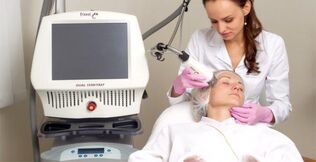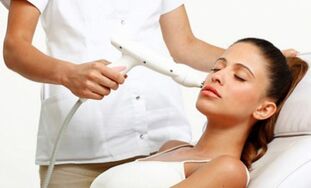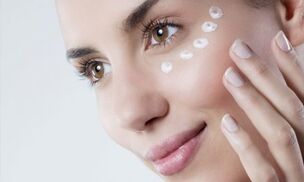Aging is a natural biological process that affects all tissues of the human body, including those that make up the human appearance. At the same time, facial tissues are more susceptible to aging than others because they are constantly under the influence of environmental factors, chewing, facial expressions and speech functions. Since the face is a kind of "business card" of a person, the issue of maintaining and restoring the youth of the facial skin is especially important and topical. Among the many methods and techniques used to solve this problem today, special attention is paid to facial laser rejuvenation.
The essence of this method is the fractional action of the laser beam on the skin. The laser stream is divided into many thinner rays, which affect the microscopic areas of the skin, located at a strictly defined depth, and evaporate them. The intact cells located between these areas stimulate the active production of collagen and elastin - the two main "building blocks" that are becoming less and less formed in the human body with age. After this procedure, the skin color improves, small and medium wrinkles are corrected, bags under the eyes are removed and the facial oval is tightened. At the same time, the rehabilitation period is minimized. Fractional laser rejuvenation can be used not only as an independent method, but also to improve the results of plastic surgery or laser skin resurfacing.

Lasers used for fractional laser rejuvenation
For the first time in the world, in 2004 the American company Palomar Medical Technologies adopted the patent principle of fractional laser impact. Fractional laser systems are currently represented by various laser technology companies. The most common are laser systems from Palomar and Fraxel, Affirm laser from the famous American company Cynosure, GentleYAG laser from Candela and others. Since all of these attitudes have a common principle of operation, the outcome of the procedure is largely determined by the professionalism of the specialist who conducts the procedure.
Contraindications for laser rejuvenation procedure
The absolute contraindications for the procedure are:
- Pregnancy, lactation.
- foci of inflammatory process in the affected area.
- Psoriasis and dermatoses.
- Outbreaks of herpes infection in the affected area.
- Chemical peeling of the treatment site for less than two weeks before the procedure.
- Oncological diseases.
- Systemic diseases of the blood, immune system, connective tissue.
- Diabetes at the stage of decompensation.
- Severe forms of hypertension and coronary heart disease.
- Varicose veins around the procedure.
- Tendency to produce keloid scars.
- Family history of vitiligo.
Relative contraindications include active exposure to the sun for the last three weeks before the procedure, ie the presence of clean burns, as well as superficial and middle peels that are applied to the treatment area three weeks before the procedure.
Advantages of fractional laser rejuvenation
Thanks to thespot effect, skin damage is minimal, so all traces disappear within 3-4 days after the procedure.
Themethod allows you to treat large areas of skin in a single procedure, maintain and activate the skin's regenerative resource, ensuring rapid rehabilitation and long-term positive effect growth.
The procedure does not require anesthesia, it can be performed around the neck, décolleté and eyes.
Side effects are rare. Possible complications include the temporary appearance of reddish-purple spots during treatment, small and rapidly transient itching, intensification of herpes infection, changes in skin texture, including burns, peeling, and crusting. Skin scarring, hyper- and hypopigmentation around the procedure are very rare, but they can be permanent.
What is the full course of laser rejuvenation procedures
One session of fractional laser exposure lasts 20-40 minutes, depending on the nature of the problem and the area of the treated area. Repeat procedures are performed in 3-4 weeks. It usually takes 3-4 sessions in total. The maximum positive effect occurs within three months after the end of the last procedure. Repair sessions are recommended once every 10-14 months.

What to do after a laser facial rejuvenation procedure
The slight burning sensation you may feel after the procedure will disappear in 1-2 hours, while the redness and slight swelling may last for 1-3 days. External agents containing dexpanthenol (creams, ointments, sprays) such as Bepanten, Panthenol, D-Panthenol should be used during this period. After the disappearance of the listed symptoms and before the next procedure, apply a cream with hyaluronic acid.
You can take a shower and wash on the day of the procedure, but it is better to wait in the sauna and pool. The fund can be used one day after the procedure.
It is mandatory to use sunscreen with at least 30 sunscreens, as this activates the skin's metabolism and makes it particularly sensitive to the sun's rays.
After completing the procedure, it is necessary to follow the recommendations of the specialist who performed the procedure. The choice of cosmetic products, the frequency and duration of their use is determined individually and depends on the skin type and its characteristics.
Fractional laser rejuvenation is a cosmetological procedure in which the skin is exposed to a laser array made of microbial rays. The purpose of this effect is to activate regeneration processes and collagenogenesis. This is a relatively new but already very popular hardware technique. It is otherwise called fractional, fractional laser surface or photothermolysis.
principle of action and fractional laser rejuvenation;
How does a fractional laser work? The micro-rays emitted by the apparatus cause heat shock, in response to which the "lazy" skin cells begin to function more actively. To repair the damaged area, they split faster. Old cells that have not been operated on die and are replaced by young ones. Warming of the deeper layers of the skin is accompanied by partial denaturation of proteins, as well as new components of the cellular matrix, including elastin and collagen.
Depending on the depth of impact, ablative and non-ablative laser rejuvenation are distinguished. The first is superficial and looks like grinding. Laser treatment of the upper layers of the skin is accompanied by evaporation of moisture, damage to the epidermis. After healing, the skin becomes more toned, its relief and color are evened out. During non-ablative photothermolysis, the laser acts on the deeper layers of the skin. In this case, no open wounds are formed.
Each type of rejuvenation has its advantages and minutes. Thus, the surface effect of the ablation laser is noticeable after the first procedure. With this method you can get rid of deep wrinkles and age spots, acne, stretch marks, scars. With a non-ablation procedure, there is no risk of infection and a rejuvenating effect is observed for several years. This type of photothermolysis is recommended for people under the age of 40, at the first sign of aging: fine wrinkles, reduced turgor.
Instructions and contraindications for the procedure
You should apply photothermolysis if possible:
- Thin, tense skin.
- Both thin and deep wrinkles, raven legs.
- pigmentation of any origin.
- Increased secretion of fat.
- enlarged pores, prone to rash.
- Scars, stretch marks, rashes.
- vascular "stars" (couperose).
- boring facial color.
- Allergy, psoriasis.
- Autoimmune diseases.
- Pregnancy, breastfeeding.
- Blood diseases.
- Skin infections, inflammatory sides for treatment.
- Any chronic disease at the stage of decompensation.
- Oncology.
- increase in body temperature.
- Diabetes mellitus.
- Tendency to produce keloid scars.
- epilepsy.
Laser Rejuvenation Features
Preparation for the fractional photothermolysis procedure is a refusal to visit the solarium and the beach for two weeks. During all this time, you also can not cleanse the skin, do chemical peels, take sulfanilamides, fluoroquinolones, tetracyclines. Three days before the procedure, they are treated at the pool, bath, sauna, with alcohol-containing cosmetics to treat the site of the alleged impact. To prevent complications, your cosmetologist may prescribe antiviral and antibacterial drugs for this period. The day before the procedure should be conducted without alcohol and cigarettes, refrain from walking to the gym.
Before laser treatment, the skin is cleansed of cosmetics and impurities. In general, the effect of the laser is to feel the unpleasant pain, but sometimes it may be necessary to relieve the pain. In this case, the cosmetologist administers anesthetics to the prepared skin area. After the ointment works, it continues with laser treatment of the skin. The duration of the procedure depends on the size of the treatment area and ranges from a few minutes to an hour. Finally, soothe the skin with a nourishing cream.
In the first days after the procedure, you should not use alcohol-based products, compress the parts of the body where the photothermolysis was performed, with compression underwear. It is recommended to exclude physical activity for a week, visit the pool, sauna or bath, limit the time spent on the street. The skin is moisturized with a special cream three times a day. So for half a month. It is undesirable to do peeling, use cosmetics with retinol, salicylic acid. For two months it is necessary to use a cream with a sun protection factor of 35 or more.
How many procedures do you need to achieve the result? What effect can you expect?
The rehabilitation period after laser fractional rejuvenation lasts from 3 to 7 days. The speed of recovery depends a lot on lifestyle. Alcohol consumption, smoking, overactivity, unbalanced diet, insomnia and anxiety - all of these can slow down regeneration processes.
Redness and slight swelling of the skin may occur during the first three days after laser exposure. Anesthetics and skin cooling can reduce the feeling of discomfort. It is normal if the skin tightness is felt in a week, here are the scaly areas. A side effect of the procedure may be a bronze tan that disappears on its own after half a month.
After fractional photothermolysis, permanent results occur after 2-5 procedures. More specifically, the number of sessions can be determined only by a cosmetologist, based on the initial data. The interval between procedures is 3-4 weeks. As a result of fractional laser rejuvenation, aging processes are inhibited: wrinkles disappear or become less noticeable, turgor increases, the pore weight decreases and facial color improves. This method is an effective tool in the fight against scars, pigmentation, subsequent bumps, stretch marks.
Laser fractional rejuvenation is one of the three most popular cosmetic procedures for equipment. Its advantages include efficiency, short treatment period, physiology. The result is visible after the first procedure and lasts up to three years. The method has a wide display. It is possible to choose the depth of laser exposure.
A woman of any age wants to see beautiful skin in a mirror, but not everyone is ready to go under a plastic surgeon's knife.
In this case, fractional rejuvenation is achieved using a laser, which occupies one of the first places in modern cosmetology in anti-aging procedures.
Types and methods of impact
Ablation photothermolysis
There are two methods of photothermolysis, each suitable for different cases. The right choice in favor of the best option will help the cosmetologist to make the first appointment.
This method is suitable for rejuvenating skin that has just started natural aging.
Laser-assisted micro-damage network affects only the upper layers of the epidermis, forcing it to regenerate in a short time.
The result will appear after the first procedure, as soon as the wounds heal.
Non-ablative photothermolysis
This method is a slightly more serious intervention. The laser beam penetrates into the deeper layers of the epidermis, lining the outer cells.
Injury also promotes the production of elastin and collagen as during ablative photothermolysis.
The healing process takes longer and the effect is more pronounced. Suitable for getting rid of serious face problems.
Readings
Anyone who wants to rejuvenate without serious braces can use this method.
Fractional laser treatment fights many facial imperfections, including:
- very pronounced wrinkles on the forehead;
- Nasolabial folds;
- flowering foot thread around the eyes;
- epidermis, "flowing down";
- skin pigmentation, scars, scars, spider veins;
- Problem with enlarged pores, acne.
It has been shown that laser therapy is very effective in eliminating all these problems.
The only caveat is that due to the severity of the imperfection, several procedures may be required.
Contraindications
Like any other external influence on the body, fractional laser rejuvenation has its own contraindications, in the presence of which the use of such a procedure is prohibited.
This includes:
- presence of acute inflammation on the face;
- Infectious, fungal skin lesions;
- Diseases of the epidermis - psoriasis, eczema;
- Excessive dryness of the skin;
- malignant neoplasms in the body;
- History of epilepsy;
- heart disease;
- varicose veins on the face;
- herpes in the acute stage;
- Pregnancy, breastfeeding;
- immunodeficiency conditions;
- bronchial asthma, severe allergic reactions;
- Neurological diseases.
All contraindications are conditional, ie the cosmetologist weighs all the risks to the patient.
Sometimes it is necessary to first treat skin problems or wait for the remission of chronic diseases, after which rejuvenation occurs again.
Preparation
Since the intervention is not a surgical operation, no serious preparation is required. You should first consult a cosmetologist who will assess the condition of the skin and also give you recommendations regarding the necessary method of photorejuvenation.
The patient is obliged to inform the doctor about all the conditions and diseases in the history, as well as about the exacerbation of chronic diseases during the last six months.
In case of such, the specialist recommends to visit specialized doctors to evaluate the safety of the procedure.
You should also have a blood and urine test to detect or rule out inflammatory processes in the body. The date of the first visit is then determined.
Execution
Fractional laser skin rejuvenation of the facial area is performed on an outpatient basis, ie the patient enters, is treated, and then he goes home.

Cosmetologist will first use an anesthetic cream or ointment based on lidocaine on the epidermis.
In fact, the procedure is not overly painful, so sometimes therapy is conducted without going through this stage.
Note that the use of local anesthetics slightly impedes the skin's natural regeneration.
Then the patient is lying on the couch and the specialist adjusts the depth of penetration of the laser beam on a special device. The device is aimed at certain areas of the epidermis, the depth of which the laser reaches.
Manipulation lasts for half an hour or more, depending on the treatment area of the device. During the procedure, the patient may feel the slightest tingling sensation as well as an unpleasant odor.
Immediately after the session a grid of red dots appears on the face, the skin is red, slightly swollen, so it is best to take care in advance to return home.
Possible complications
Fractional rejuvenation does not rule out complications. In some cases, they are normal and disappear in a few days.
Others develop due to inexperience in cosmetology or lack of proper facial care during the rehabilitation period.
What is not the norm:
- Severe pain or swelling at the site of exposure to the laser beam;
- Injury does not heal in two weeks;
- pigmentation and scars appeared.
Light redness, scaling, and itching are a predictable condition of any type of epidermis.
Such results disappear by themselves within 1-2 weeks, without visual defects.
Rehabilitation
The outcome of the procedure is greatly influenced by the patient's behavior. She should carefully control the skin, protect it from aggressive environmental influences, do not use decorative cosmetics during healing.

General instructions:
- For the first three days of the wound you should lubricate with dexpanthenol-based ointment,this will help the micro-lesions heal faster. It is further recommended to use a light moisturizer with hyaluronic acid, which was advised by a cosmetologist.
- Bathing is prohibited.For 2 weeks the epidermis should not be exposed to strong heat, so it is better to refrain from baths and saunas, do not take hot baths.
- You should not go outside without sunscreen,and it is best to choose 50 protection. If this is not done, hyperpigmentation will appear. The cosmetic product should be used until complete healing, even if it is winter outside.
After a couple of weeks it is recommended to visit again a specialist who has performed fractional laser rejuvenation. He should assess the condition of the facial skin, to rule out complications.
forecast
The result can be seen immediately after healing if the defects were not very pronounced. Deep wrinkles or scars should be removed through several treatments.
Visually, the skin is smoother, has a natural color, the face is tight and obviously blooming in 99% of cases.
One percent was devoted to unforeseen circumstances, inadequate care, and lack of physician qualifications.
Advantages of themethod
Many patients are excited about this method, with significant benefits that are worth mentioning. By choosing photothermolysis, a person gets the following:
- Low cost with high efficiency;
- painlessness;
- effect from even one procedure;
- non-invasiveness;
- Lack of strong side effects.
In addition, the laser effect solves several problems with the aesthetic component of the epidermis, which is good news.
Disadvantages
If you choose the wrong clinic for rejuvenation or do not strictly follow the recommendations of a cosmetologist, you can get huge age spots on half of the face, which will not be easy to remove.
In addition, laser treatment takes quite a long time, during which the patient feels an unpleasant odor on the damaged skin, which not everyone can stand.
Another disadvantage is the incomplete result from one procedure with deep depressions, scars and wrinkles.Review of opinions
Fractional rejuvenation is gaining popularity in cosmetology. Every year more and more women choose laser instead of surgical scalpel.














































































